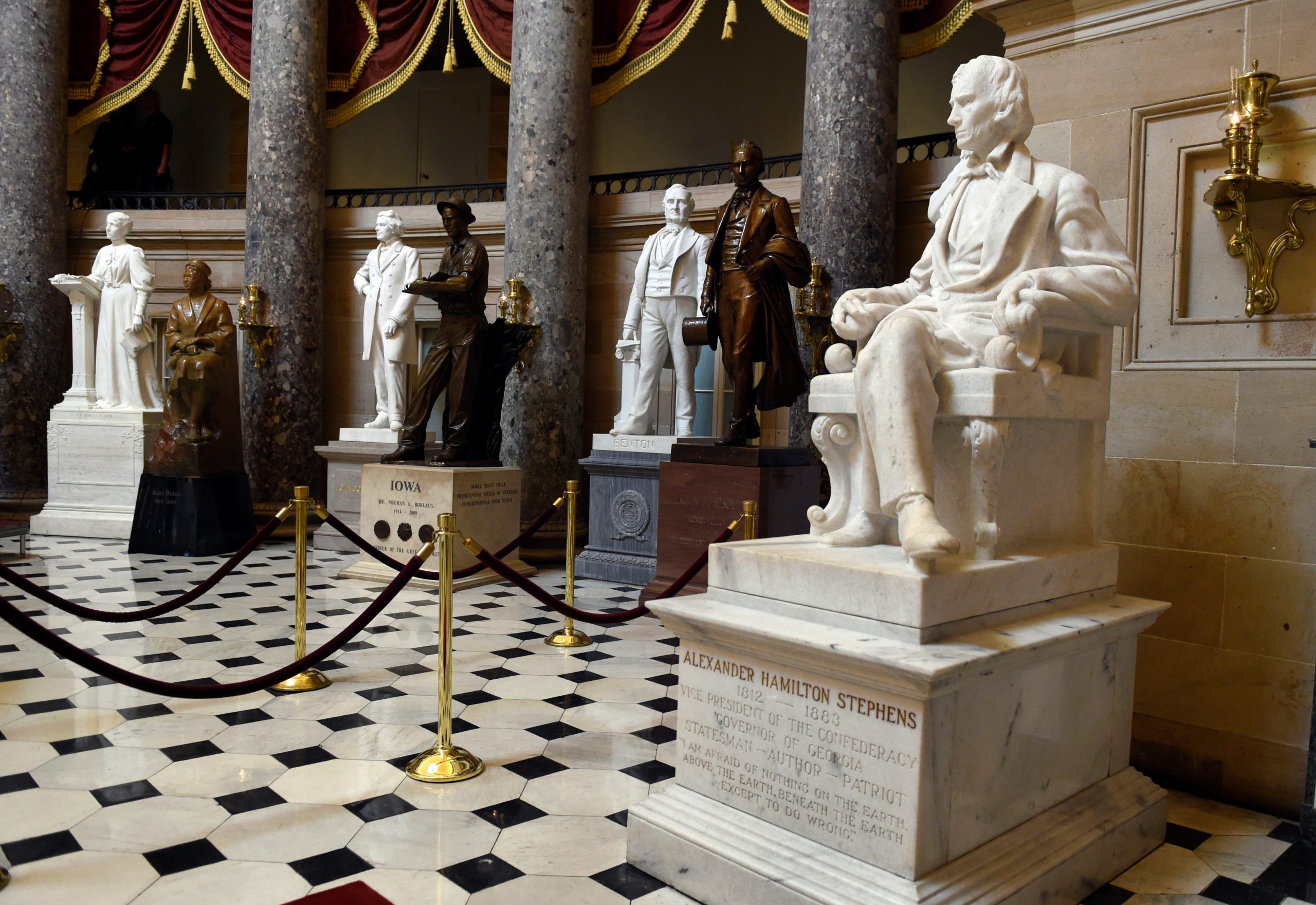

- The House passed similar legislation last year, but it stalled in the Republican-controlled Senate.
- Each state contributes two statues of historically important people to be displayed in Statuary Hall
- Any statue removed and not owned by a state would be up to the Architect of the Capitol to address.
WASHINGTON – The House passed a bill Tuesday that would remove Confederate statues from the U.S. Capitol as well as a bust of the former Supreme Court chief justice who wrote the 1857 Dred Scott decision that denied enslaved people the right to be citizens.
"This sacred space, this temple of democracy has been defiled for too long. We ought not to forget history. We must learn from history. But we ought not to honor that which defiles the principles for which we ... stand," House Majority Leader Steny Hoyer, D-Md., said on the House floor before the vote. "It's time to remove those symbols of slavery, segregation and sedition from these halls."
The bill passed by a vote of 285 to 120. Every Democrat present and 67 Republicans voted for it. The bill heads to the Senate for consideration, where it would need 10 Republican senators to join every Democrat to pass the upper chamber.
The legislation would require states to remove and replace any statues honoring members of the Confederacy in the National Statuary Hall Collection in the Capitol by prohibiting "persons who served as an officer or voluntarily with the Confederate States of America or of the military forces or government of a State while the State was in rebellion against the United States" from the collection.
Though a number of Republicans supported the bill, they used the debate to point out Democrats represented the South during the Civil War and the era of Jim Crow. House Minority Leader Kevin McCarthy, -Calif., criticized Democrats as hypocrites on race.
"The Democratic Party has doubled down on what I consider this shameful history by replacing the racism of the past with the racism of the critical race theory," he said, referring to the academic examination of systemic racism in American life that has become a rallying cry for conservatives.
The House passed similar legislation last year, but it stalled in the Republican-controlled Senate. It has a greater chance of passage now that Democrats hold the majority.
Hoyer reintroduced the legislation in May, saying, "It’s never too late to do the right thing, and this legislation would work to right a historic wrong while ensuring our Capitol reflects the principles and ideals of what Americans stand for."
Each state contributes two statues of people of historical importance to be displayed in the Capitol's National Statuary Hall – ranging from Revolutionary War hero Ethan Allen from Vermont to disability rights activist Helen Keller from Alabama.
Statues include notable segregationists
The bill calls for the removal of a bust of former Supreme Court Chief Justice Roger Taney, who wrote the Dred Scott decision in 1857, which declared enslaved people were not citizens and did not have the right to sue.
"Why should they occupy a place of honor and reverence in this building?" said Rep. Jamie Raskin, D-Md., who noted that Taney's hometown of Frederick, Maryland, removed the statue of its native son five years ago.
"In the name of original intent, Justice Taney transformed our Constitution into a white man's compact," Raskin said. "He disgraced the Supreme Court. It would take the Civil War, the Reconstruction amendments and the civil rights rights movementto dismantle the white supremacist constitution."
Taney's bust, which sits inside the Old Supreme Court Chamber in the Capitol, would be replaced with one of Thurgood Marshall, the first African American Supreme Court justice.
Rep. Glenn Grothman, R-Wis., said he opposed the bill because of Marshall's support for Roe v. Wade, the decision that legalized abortion in 1973.
"I will always look at him as ... the guy who kind of put the foot on the gas and legalized late-term abortion," he said.
Fact check: Viral post on Supreme Court's Dred Scott ruling includes inaccuracies
The bill would remove the statues of former Vice PresidentJohn Calhoun, North Carolina Gov.Charles Aycock and Arkansas Sen. John Clarke, whom the legislation identifies as playing a major role in defending slavery and segregation.
If the statues were provided by a state – for example, Calhoun was provided by South Carolina – the Architect of the Capitol, the office tasked with preserving the Capitol, would send them back. States would be allowed to replace statues.
"What we should do today is relegate these statues to the dustbin of history," said Rep. James Clyburn, D-S.C.
Any bust or statue that is removed and not owned by a state would be left up to the Architect of the Capitol to address.
Confederate monuments have reemerged as a national flash point since Floyd's death: More than 90 Confederate monuments were taken down or moved from public spaces in 2020, according to February data from the Southern Poverty Law Center.
Nearly 800 Confederate monuments were in the USA at the beginning of 2020, a number that dwindled to about 700 by the end of last year.
More:Nearly 100 Confederate statues were removed in 2020, but hundreds remain, new SPLC data shows
History of Confederate statues
Like other symbols of the Confederacy, such memorials have been defended for generations as pieces of Southern heritage or artifacts of history. But for many people, they are reminders of racial discrimination and violent oppression that has never gone away.
Hoyer said Tuesday the legislation "is to dishonor hate."
"We cannot forget that we had hate. We cannot forget that segregation and slavery existed, nor should we, but we ought not to honor those who pursued those efforts, particularly during the Civil War and leading up to the Civil War," he said. "We can't change history, but we can certainly make it clear that which we honor and that which we do not honor. Symbols of slavery, sedition and segregation have no place in the halls of Congress."
The Capitol has 10 Confederate statues, a few of which are already in the process of being removed and replaced by the states that sent them.
A statue of Confederate Gen. Robert E. Lee that stood in the U.S. Capitol on behalf of the state of Virginia for 111 years was removed and taken to a museum in Richmond in December, per the request of state leaders.
More:House overwhelmingly votes to make Juneteenth a federal holiday, sending bill to Joe Biden
More:Qualified immunity divides lawmakers in police reform talks. What is that legal defense?
In 2020, House Speaker Nancy Pelosi, D-Calif., ordered the removal of four portraits in the U.S. Capitol of former House speakers who served in the Confederacy.
Many protesters and activists have demanded the removal ofConfederate statues in cities across the country and the renaming of military bases honoring Confederate military leaders, and Republicans have expressed some openness.
Rep. Barry Loudermilk, R-Ga., said he disagreed with the process in which the legislation was brought forward and how it would remove the statues.
"My opposition to this bill isn't because of the goal that we're trying to achieve, but it's the way that the majority continues to skirt procedure in this body for the second consecutive Congress," Loudermilk said.
Other Republicans, including former President Donald Trump, have vehemently denounced the changes.
Some Republican senators have expressed hesitation about removing the statues, such as Minority Leader Mitch McConnell, R-Ky., who said in 2020, "What I do think is clearly a bridge too far is this nonsense that we need to airbrush the Capitol and scrub out everybody from years ago who had any connection to slavery."
The Senate overwhelmingly passed a massive defense bill last July that included the removal of Confederate names from military bases.
Contributing: N'dea Yancey-Bragg, Christal Hayes
Follow Savannah Behrmann online @SavBehrmannDC







